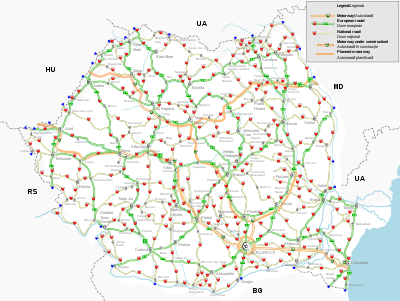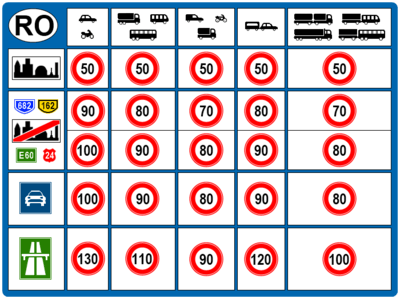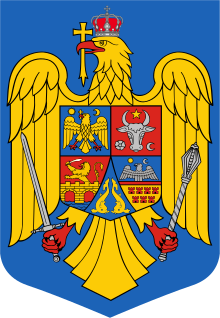Transport in Romania
As a densely populated country in a central location in Central-Southeastern Europe and with a developed economy, Romania has a dense and modern transportation infrastructure.
| Transport in Romania |
|---|
| Companies |
| History |
|---|
| Companies |
|
| Industry |
|
| Rankings |
|
| Related topics |
|
Transportation infrastructure in Romania is the property of the state, and is administered by the Ministry of Transport and Infrastructure, Constructions and Tourism, except when operated as a concession, in which case the concessions are made by the Ministry of Administration and Interior.[1]
The country's most important waterway is the river Danube. The largest port is that of Constanța, which is the second largest port at the Black Sea.
With over 13 million passengers Bucharest Airport is a major international airport and European transportation hub. Air travel is used for greater distances within Romania but faces competition from the state-owned CFR's rail network. Public transport is available in most areas.
History
Romania has a system of large, navigable rivers, such as the Danube, Olt and Mureș that cross the country.
The first important human improvements were the Roman roads linking major settlements and providing quick passage for marching armies.
Railway transport

A fast-growing number of Romania's major cities have modern tram or light rail networks, including Bucharest, Timișoara, Cluj-Napoca and Oradea. Recently the tram has seen a very big revival with many experiments such as ground level power supply in Oradea.
Roads and automotive transport


According to CIA Factbook, Romania total road network is estimated to be 198,817 km long, out of which 60,043 km are paved and 138,774 km (2004) are unpaved.[2] The World Bank estimates that the road network that is outside of cities and communes (i.e. excluding streets and village roads) is about 78,000 km long.[1]
Motorways
Motorways are identified by A followed by a number. As of December 2019, Romania has 850,24km of motorway completed with another 230 km under planning or construction. In recent years, a master plan for the national motorway network has been developed and approved by the European Commission in July 2015.
Currently A1_motorway_(Romania), part of the Pan European IV Corridor the northern branch, with a length of 576.72 km has opened 442 km and under construction are the segments Lugoj—Deva lot 2(13 km), whereas Sibiu—Pitești 116.64 km is tendered.
A2_motorway_(Romania) is the only motorway in Romania opened on all its segments, it has a length of 205 km.
A3_motorway_(Romania), which is the largest motorway project in Europe with a length of 588 km from Bucharest to Oradea (near the Hungarian border), has 123 km opened and also has under construction the 64 km segment between Oradea (Bors) and Suplacu de Barcău which has been re-auctioned after the contract with Bechtel was annulled, and now the works are in progress. Also Câmpia Turzii—Târgu Mureș 51.8 km the works are in progress, all three segments are due in 2016; the segment Nădășelu—Mihăiești 16.8 km is tendering and Bucharest bypass—Bucharest 6.5 km will be re-auctioned after the contract with Pizzarotti was cancelled; the remaining segments totaling 332.6 km are still in the planned phase, even though the segment Comarnic—Brașov 54 km might be tendered in the near future. The entire project is expected to be finished in 2018.
A4_motorway_(Romania) also called Constanța bypass because it goes around the west side of the city. It has 22 km opened, from Ovidiu to Agigea, and also has 45 km planned, from Agigea to Vama Veche (at the border with Bulgaria).
A6_motorway_(Romania) is also part of the Pan European IV Corridor like A1, but near Lugoj it starts the southern branch, that connects the cities of Sofia, Istanbul and Athens. It has a length of 270 km, of which 11.4 km between A1 and Lugoj bypass are opened.
A10_motorway_(Romania) is the first motorway which will link two other motorways in Romania: A1 (near Sebeș) and A3 (near Turda). It has 70 km, and all segments are under construction and are due completion in 2016.
A11_motorway_(Romania) is a 135 km motorway, the second to connect A1 with A3 this time between Arad and Oradea, of which a 2.4 km stretch near Arad called "Arad bypass" has been opened.
Statistics
According to the Romanian "Direcţia Regim Permise de Conducere şi Înmatriculare a Vehiculelor", in 2017 in Romania there were 7,635,000 vehicles from which 1,320,230 in Bucharest. [3]
Metro
Bucharest is the only city in Romania which has an underground railway system, comprising both the Bucharest Metro and the light rail system of the Regia Autonomă de Transport București. Although construction was planned to begin in 1941, decades of delays meant the Bucharest Metro was only opened in 1979. It now forms the backbone of the Bucharest public transport network with an average of 800,000 passengers during the workweek.[4] In total, the network is 71 km long and has 53 stations.
Proposals to build metros have been put forward for Cluj-Napoca[5]and Timișoara
Air transport
The air traffic in Romania reached 20.28 million passengers in 2017.[6]
The national carrier of Romania is TAROM, a full service airline which flies to 9 domestic destinations and 30 international destinations in 23 countries.
Airports
There are 20 airports in Romania (estimated as of 2006).
Water transport
Romanian companies operate over 700 ships of which 400 are registered in Romania. Romania's 110 shipping firms employ 12,500 personnel at sea and 15,500 on shore. Each year, 105 million tonnes of goods and 1 million passengers are transported by sea. Marine transport is responsible for 52% of Romania's imports and exports.
Ports
- With terminals:
- Port of Constanța (the largest port and shipyard in the Black Sea and one of the busiest ports in Europe)
- Port of Galați (on the Danube)
- Brăila (on the Danube)
- Tulcea (on the Danube)
- Other Black Sea ports:
- Other ports on the Danube:
- Ports on the Danube-Black Sea Canal:
- Cernavodă
- Poarta Albă
- Constanța Sud
- Agigea
See also: Romanian river ports
Waterways
As of 2006, there are 1,731 km of navigable waterways of which:
- 1,075 km on Danube River
- 524 km on secondary branches
- 132 km on canals
In 2004, according to europaworld.com, 19 million passenger-km and 4 billion ton-km were carried through these waterways.
Merchant fleet
The merchant marine has seen a dramatic drop in capacity during the first decade of the 21st century:
- from 142 ships (1,000 gross tonnage (GT) or over) totaling 1,154,127 GT/1,612,314 tonnes deadweight (DWT) 1999
- to 19 ships (1,000 GT or over) 146,307 GT/165,548 DWT in 2007.
These include: 13 cargo ships, 1 passenger ship, 2 passenger/cargo ships, 2 petroleum tankers, 1 roll-on/roll-off.
50 other ships are registered in other countries: Cambodia 1, Georgia 15, North Korea 6, Malta 10, Marshall Islands 1, Panama 8, Sierra Leone 2, Saint Kitts and Nevis 1, Saint Vincent and the Grenadines 1, Syria 4, Tuvalu 1, unknown 4.
International sea-borne freight traffic
- goods loaded: 18.2 million tons
- goods unloaded: 22.3 million tons (2004)
Pipelines
- Oil: 2,427 km
- Natural gas: 3,508 km (2006)
See also
- List of airports in Romania
- License plates in Romania
- List of motorways in Romania
- Tourism in Romania
References
- Romania : transport worldbank.org
- The CIA world factbook :Romania www.cia.gov
- "Parcul auto in detaliu. Cate masini din fiecare marca exista in Romania".
- http://www.railway-technology.com/projects/bucharest-metro/%5B%5D
- "Infrastructura.info". infrastructura.info.
- http://www.economica.net/record-pentru-aeroporturile-din-romania-in-2017-peste-20-de-milioane-de-pasageri-transportati_149516.html
External links
| Wikimedia Commons has media related to Transport in Romania. |
